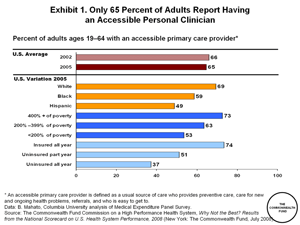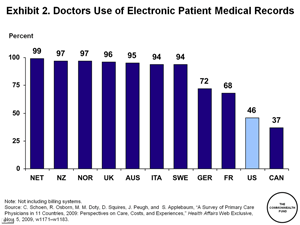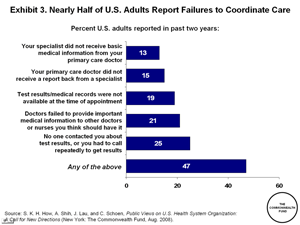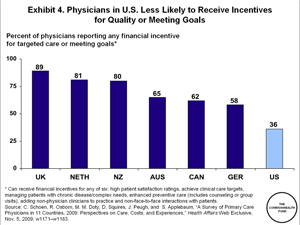In my last blog post, I discussed the ways the new health reform law improves the affordability of insurance for a variety of populations, including the uninsured and the underinsured and older and younger adults. The Affordable Care Act also includes a host of lesser-known provisions that, together, place a new emphasis on preventive and primary care and reward quality. These key features will ultimately push the health care system to deliver more patient-centered, accessible, and coordinated care. Below, I outline some of the reforms that will change people's experiences in the doctor's office and hospital.
Under the new reforms, patients will be more likely to have:
A physician practice that is accessible 24/7 and helps arrange specialist appointments.
A strong network of primary care physicians is central to a high performance health system that works for everyone. Yet only two-thirds of American adults under age 65 report having an accessible primary care provider (Exhibit 1). In addition, nearly three-quarters of all adults were not able to see their doctor quickly when sick, found it difficult to get through to their doctors by phone, or said it was difficult to get care after regular work hours without going to the emergency room.
 Health reform will test a new model of care that changes the way health care is organized. Patients can enroll in a patient-centered medical home, which is accountable for ensuring that patients get all recommended care. By offering care on nights and weekends, by using information technology and office systems to remind patients about preventive care, and by assisting them with obtaining needed specialty care, medical homes provide high-quality, coordinated care.
Health reform will test a new model of care that changes the way health care is organized. Patients can enroll in a patient-centered medical home, which is accountable for ensuring that patients get all recommended care. By offering care on nights and weekends, by using information technology and office systems to remind patients about preventive care, and by assisting them with obtaining needed specialty care, medical homes provide high-quality, coordinated care.
Financial incentives will help these practices succeed. New pilot programs will support and reward practices with an extra "medical home fee" paid by insurers and public programs. Moreover, they can earn bonuses for ensuring that their patients receive preventive care and help with managing a chronic illness. Care teams, including physicians, nurses, pharmacists, and other health professionals, will ensure coordination of care and shared accountability for health outcomes. To support provider groups as they reorganize—a challenging task even for large providers—the government will begin to fund regional or state health information exchange networks, and test strategies for ensuring access to after-hours care, case management help, and more.
The new law will also establish a Center for Medicare and Medicaid Innovation, effective January 2011, to oversee and test these and other innovative payment methods. Priority will be given to models that both improve quality and reduce costs, such as medical homes, accountable care organizations that assume responsibility for quality and cost across the continuum of patient care, funding for care coordination, and bundled payment for hospital acute and post-acute care.
By increasing primary care payment rates, and making low-interest student loans more available, the Affordable Care Act also aims to increase the supply of primary care physicians and advanced practice nurses, making it easier for patients to find a primary care provider.
Better access to community health centers able to serve more patients.
Federally qualified health centers provide comprehensive primary care and mental health services to some of our nation's most vulnerable individuals and families. Recent Commonwealth Fund analysis shows that of the 16 million patients who received care from health centers in 2007, 90 percent were at or below 200 percent of the federal poverty level, 45 percent had public insurance, and 40 percent had no insurance at all.
The Affordable Care Act expands funding to community health centers by $11 billion over five years beginning in 2010; provides state grants for health care providers that serve a large percentage of medically underserved populations; and provides for a Medicaid global payment system demonstration project that allows up to five states to make global capitation payments—covering all services provided to a patient during an episode of care—to safety-net hospitals from 2010 to 2012. It also provides grants to assist in development of community-based collaborative care networks, or integrated health care delivery systems, to serve low-income or medically underserved communities from 2011 to 2015.
 Electronic medical records that ensure, with the patient's authorization, complete medical records are accessible when needed.
Electronic medical records that ensure, with the patient's authorization, complete medical records are accessible when needed.
U.S. health providers have been slow to adopt electronic health information systems, in part because of concerns about the value and the costs of implementation. A 2009 Commonwealth Fund survey of primary care physicians shows that the U.S. is far behind most of its industrialized peers in the use of health information technology (IT) (Exhibit 2).
Without an information system that ensures the right information is available at the right time, tests are repeated, appointments with specialists have to be rescheduled, and patients are not informed about abnormal lab tests in a timely manner (Exhibit 3). The American Recovery and Reinvestment Act of 2009 provides financial assistance for physicians and hospitals to adopt health information systems to report quality information, deploy decision support to help providers provide the best care, and improve the quality of care. The Affordable Care Act provides further incentives to establish such information systems: it rewards high-quality care and enables health care organizations that assume responsibility for total patient care to share in the savings.
 Doctors and hospitals that are rewarded for higher quality and better patient outcomes.
Doctors and hospitals that are rewarded for higher quality and better patient outcomes.
The prevailing fee-for-service payment system rewards physicians for the volume of care they provide, rather than the value of that care. The U.S. lags behind its counterparts in this regard (Exhibit 4).
The new reform law will reward hospitals for achieving benchmark levels of performance in heart attack, heart failure, and pneumonia care, and for preventing surgical infections. Starting in October 2012, hospitals that meet or exceed the designated performance standards will receive enhanced Medicare payments, taken from a pool of money collected from all hospitals. By 2012, the Secretary of Health and Human Services (HHS) is required to submit a plan to Congress on how to move home health and nursing home providers into a value-based purchasing payment system.
The legislation also includes physician payment reforms that encourage physicians, hospitals, and other providers to join together to form accountable care organizations to gain efficiencies and improve quality of care. Those that meet quality-of-care targets and reduce costs relative to a spending benchmark can share in the savings they generate for Medicare. Furthermore, all physicians and hospitals meeting benchmarks for high-quality care will be eligible for bonuses under new value-based purchasing provisions. 
Better information and support when discharged from the hospital.
U.S. hospital readmission rates for Medicare patients within the first 30 days following discharge range from 14 percent to 21 percent. Inadequate communication during care transitions—when patients are discharged from the hospital to home or to a nursing facility, for example—often contributes to readmissions or avoidable complications. The Commonwealth Fund is working with Massachusetts, Michigan, and Washington State on the State Action on Avoidable Rehospitalizations (STAAR) initiative to test interventions that reduce readmissions, such as making sure patients have the information they need for self-care and have scheduled a follow-up appointment with their physician.
Medicare payments will be reduced for hospitals with high rates of potentially preventable readmissions for certain eligible conditions or procedures, as determined by the HHS secretary. In addition, by 2013, HHS will develop a national, voluntary pilot program encouraging hospitals, doctors, and post-acute care providers to test "bundled" Medicare payment models spanning three days before and 30 days after a hospitalization. If the pilot programs improve care and reduce spending, HHS is required by 2016 to submit a plan for expansion.
Hospitals with an incentive to reduce hospital-acquired infections.
The new legislation demands greater transparency and public reporting on hospitals' performance at preventing infection. Later this year, the Centers for Medicare and Medicaid Services (CMS) will begin reporting rates of medical errors and selected hospital-acquired conditions on its Hospital Compare Web site. Starting in 2011, federal payments for Medicaid services related to hospital-acquired conditions will be prohibited. Beginning in 2015, hospitals that have among the highest rates of these hospital-acquired conditions will have their Medicare payments reduced by 1 percent.
More patient information on quality of physicians, hospitals, and health plans.
Physicians who report data on the quality of their care through a qualified program will be eligible for one-half percent Medicare bonus payments. In addition, HHS will develop a Physician Compare Web site by January 2011. Combining Medicare data on quality with that of private insurers should improve the scope and reliability of information on performance. To further this aim, the legislation also authorizes, effective January 2012, the release of Medicare claims data to measure the performance of providers and suppliers in a way that protects patient privacy.
More choice of health insurance plans, including nonprofit plans.
A 2007 Commonwealth Fund survey showed that 42 percent of workers with employer-based coverage had only one choice of health plan. Even when workers have a choice of plans, the plans are often different products offered by the same insurer. Nor do all plans provide adequate benefits or ensure adequate participation of physicians in essential specialties.
Under health reform, state-based health insurance exchanges will increase the choice of high-quality private plans and health care cooperative plans, and will make it easy to compare these choices. In addition, the federal government will contract with private insurance carriers to offer multistate plans through each exchange. At least one of the new multistate plans must be nonprofit. The government will negotiate contracts, much as it does for the Federal Employees Health Benefits Program.
The new Consumer Operated and Oriented Plan (CO-OP) program, meanwhile, will foster the creation of nonprofit, member-run health insurance companies, or cooperatives, that will provide coverage and deliver health services. In making grants, priority will be given to cooperatives that operate on a statewide basis, are organized as integrated care systems, and have significant private support.
The insurance exchanges provide an important avenue for setting quality standards on insurance and care. In overseeing the exchanges, the HHS secretary is charged not only with ensuring a sufficient choice of qualified plans and providers but also with establishing certification criteria for qualified plans, requiring plans to provide the essential benefits package and meet marketing requirements, and ensuring that essential community providers are included in networks and accredited on quality.
Private plans that are rewarded for better care.
Currently, employers and Medicare beneficiaries tend to make choices based largely on premiums, without information showing whether plans are actively trying to ensure high-quality care—either through the way they select participating physicians and hospitals, or through the information and support they offer to providers regarding benchmark quality care.
Under health reform, Medicare private managed care plans that receive a four- or five-star quality designation will receive bonuses. Health plans that operate through the new health insurance exchanges will report on their quality improvement activities, including their efforts to prevent hospital readmissions. By 2015, health plans operating in the exchanges will be allowed to enter into contracts with hospitals with fewer than 50 beds only if the hospitals use a patient safety evaluation system and have implemented a comprehensive program for patient discharge.
Reduced health insurance premiums and health spending.
Between 2000 and 2009, health insurance premiums rose by 108 percent, while workers' earnings rose by just 32 percent. As a result, average family premiums for group policies have risen from 11 percent to 18 percent of median family income. In the absence of reform, premiums were projected to rise to 24 percent of a family's income by 2020. Under the new reform law, the average family stands to save nearly $2,000 or more in 2019.
Premiums will be held down by requirements that limit the percentage of premium revenue going to administrative costs, and that require carriers seeking certification as qualified health plans to submit a justification in advance for any premium increase. Premium growth will be monitored and used as a criterion for allowing plans into the exchanges.
The establishment of health insurance exchanges in 2014 will further lower administrative costs and premiums in the individual and small-business markets as transparency, choice among plans with comparable actuarial value, and new nonprofit plans enhance competition, and the requirement for people to obtain coverage broadens the risk pool.
The upward spiral of health care costs will also slow as those that pay for health care begin to adopt innovative payment methods that reward quality and value, rather than volume. For example, the new Independent Payment Advisory Board within the executive branch will have significant authority to identify areas of waste and additional federal budget savings.
A Commonwealth Fund report found that the impact of health reform on health insurance premiums and health spending will be significant. It estimates that, on net, the combination of provisions in the new law will reduce health care spending by $590 billion over 2010–19. The annual growth rate in national health expenditures would be slowed from 6.3 percent to 5.7 percent.
All Stakeholders Needed for Success
The Affordable Care Act's important payment and system reforms, along with the new insurance market protections discussed in my last post, will improve access and quality and reduce cost growth for everyone. Reform is a historic victory for all Americans. But it will require the efforts of all stakeholders to make the promise a reality.



